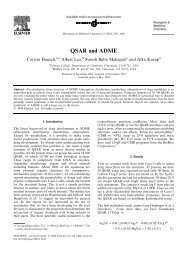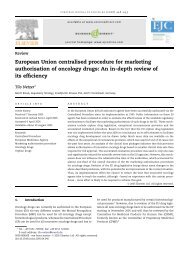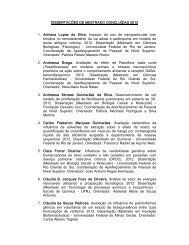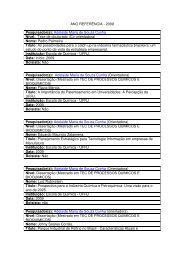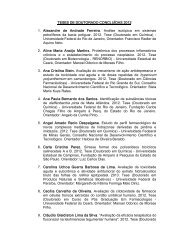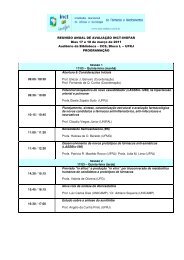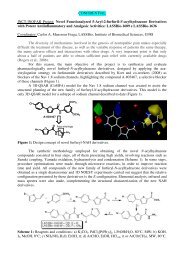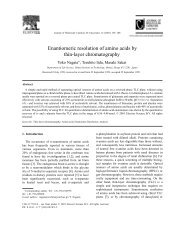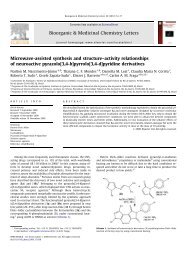View - ResearchGate
View - ResearchGate
View - ResearchGate
- No tags were found...
Create successful ePaper yourself
Turn your PDF publications into a flip-book with our unique Google optimized e-Paper software.
Perspective Journal of Medicinal Chemistry, 2004, Vol. 47, No. 18 4349and approaches in drug metabolism. His research interestsinclude application of LC/MS and radiodetection techniques,development of cell-based P450 bioreactors, metabolic bioactivation,and reaction phenotyping of metabolizing enzymes.Ronald L. Hanson received his Ph.D. in Biochemistry fromthe University of Wisconsin. After 2 years as a PostdoctoralFellow at Harvard Medical School and 7 years as an AssistantProfessor of Biochemistry at Columbia University, he workedfor 8 years at Sandoz Pharmaceuticals in the diabetes drugdiscovery section in East Hanover, NJ. For the past 16 yearshe has worked in process research and development for Bristol-Myers Squibb in New Brunswick, NJ, where he is currently aSenior Principal Scientist. His research is in the area ofbiocatalysis by microbial cells and enzymes.Vikram Roongta received his Ph.D. in Chemistry fromPurdue University, IN, in the area of biomolecular structuredetermination by NMR. He joined University of Minnesota asa Staff Scientist and for the first 4 years managed theChemistry Department NMR Facility and for the following 4years managed the Biochemistry Department NMR Facilityand performed research on solution structures of proteins byNMR. For the past 6 years he has worked in DiscoveryAnalytical Sciences Department supporting drug discovery atBristol Myers Squibb and is currently a Group Leader. Hisresearch is in the area of applications of NMR in smallmoleculestructure determination in drug discovery.W. Griffith Humphreys, Ph.D., is currently AssociateDirector in the Metabolism and Pharmacokinetics Departmentat Bristol-Myers Squibb, Hopewell, NJ. He received hisgraduate training at the University of Virginia in Chemistryand then completed a Postdoctoral Fellowship at VanderbiltUniversity in molecular toxicology. He oversees a groupresponsible for drug metabolism and pharmacokinetic studiesduring the candidate optimization phase of drug discovery. Hisinterests include drug metabolism, predictive metabolism andtoxicology models, in vitro and in vivo correlations, andstrategies for candidate optimization.References(1) Clader, J. W. The Discovery of Ezetimibe: A view from outsidethe receptor. J. Med. Chem. 2004, 47, 1-9.(2) Schmidt, B.; Schieffer, B. Angiotensin II AT1 receptor antagonist.Clinical implications of active metabolites. J. Med. Chem. 2003,46, 2261-2270.(3) Garattini, S. Active drug metabolites: an overview of theirrelevance in clinical pharmacokinetics. Clin. Pharmacokinet.1985, 10, 216-227.(4) Clissold, S. P. Paracetamol and phenacetin. Drugs. 1986, 32(Suppl. 4), 46-59.(5) Flower, R. J.; Moncada, S.; Vane, J. R. Analgesic-antipyreticsand anti-inflammatory agents: drugs employed in the treatmentof gout. In The Pharmacological Basis of Therapeutics, 7th ed.;Gilman, A. G., Goodman, L. S., Rall, T. W., Murad, F., Eds.;Macmillan: New York, 1985; pp 674-715.(6) Baldessarini, R. J. Drugs and the treatment of psychiatricdisorders. In The Pharmacological Basis of Therapeutics, 7thed.; Gilman, A. G., Goodman, L. S., Rall, T. W., Murad, F., Eds.;Macmillan: New York, 1990; pp 383-435.(7) Mattila, M. J.; Paakkari, I. Variations among non-sedatingantihistamines: are there real differences? Eur. J. Clin. Pharmacol.1999, 55, 85-93.(8) Meeves, S. G.; Appajosyula, S. Efficacy and safety profile offexofenadine HCl: a unique therapeutic option in H1-receptorantagonist treatment. J. Allergy Clin. Immunol. 2003, 112, S69-S77.(9) Murdoch, D.; Goa, K. L.; Keam, S. J. Desloratadine: an updateof its efficacy in the management of allergic disorders. Drugs2003, 63, 2051-2077.(10) Shet, M. S.; McPhaul, M.; Fisher, C. W.; Stallings, N. R.;Estabrook, R. W. Metabolism of the antiandrogenic drug (Flutamide)by human CYP1A2. Drug Metab. Dispos. 1997, 25, 1298-1303.(11) Anderson, R. J.; Kudlacek, P. E.; Clemens, D. L. Sulfation ofminoxidil by multiple human cytosolic sulfotransferases. Chem.-Biol. Interact. 1998, 109, 53-67.(12) Fisher, M. B.; Paine, M. F.; Strelevitz, T. J.; Wrighton, S. A.The role of hepatic and extrahepatic UDP-glucuronosyltransferasesin human drug metabolism. Drug Metab. Rev. 2001, 33,273-279.(13) Baillie, T. A.; Cayen, M. N.; Fouda, H.; Gerson, R. J.; Green, J.D.; Grossman, S. J.; Klunk, L. J.; LeBlanc, B.; Perkins, D. G.;Shipley, L. A. Drug metabolites in safety testing. Toxicol. Appl.Pharmacol. 2002, 182, 188-196.(14) Hastings, K. L.; El-Hage, J.; Jacobs, A.; Leighton, J.; Morse, D.;Osterberg, R. E.; Letter to the editor. Toxicol. Appl. Pharmacol.2003, 190, 91-92.(15) White, R. E. High-throughput screening in drug metabolism andpharmacokinetic support of drug discovery. Annu. Rev. Pharmacol.Toxicol. 2000, 40, 133-157.(16) Fura, A.; Lounsbury, H.; Yu, S.; Cai, X.; Yaeger, D.; Scannell,R.; Libertine, G. L.; Grewal, G.; Hussoin, S.; Killian, D. B.;Young, M.; Zuo, F.; Ellis, J.; Fisher, R.; Yeh, G. Structureactivityrelationships and rate of glucuronidation of CMI-977and its analogs. Pharm. Res. 1997, 14, (Suppl. 11), 552.(17) White, R. E. Short- and long-term projections about the use ofdrug metabolism in drug discovery and development. Drug.Metab. Dispos. 1998, 26, 1213-1216.(18) Rosenblum, S. B.; Huynh, T.; Afonso, A.; Davis, H. R., Jr.;Yumibe, N.; Clader, J. W.; Burnett, D. A. Discovery of 1-(4-Fluorophenyl)-(3R)-[3-(4-fluorophenyl)-(3S)-hydroxypropyl]-(4S)-(4-hydroxyphenyl)-2-azetidinone (SCH 58235): a designed, potent,orally active inhibitor of cholesterol absorption. J. Med.Chem. 1998, 41, 973-980.(19) Yumibe, N.; Huie, K.; Chen, K. J.; Snow, M.; Clement, R. P.;Cayen, M. N. Identification of human liver cytochrome P450enzymes that metabolize the nonsedating antihistamine loratadine:formation of descarboethoxyloaratadine by CYP3A4 andCYP2D6. Biochem. Pharmacol. 1996, 51, 165-172.(20) Norman, P.; Dihlmann, A.; Rabasseda, X. Desloratadine: Apreclinical and clinical overview. Drugs Today. 2001, 37, 215-227.(21) Hibert, J.; Radwanski, E.; Weglein, R.; Lue, V.; Prerentesis, G.;Symchowicz, S. Pharmacokinetics and dose proportionality ofloratadine. J. Clin. Pharmacol. 1987, 27, 694-698(22) Radwasnki, E.; Hilbert, J.; Symchowicz, S.; Zampaglione, N.Loratadine: Multiple dose pharmacokinetics. J. Clin. Pharmacol.1987, 27, 530-533.(23) Osborne, R.; Thompson, P.; Joel, S.; Trew, D.; Patel, N.; Slevin,M. The analgesic activity of morphine 6-glucuronide. Br. J. Clin.Pharmacol. 1992, 34, 130-138.(24) Ritter, J. K. Roles of glucuronidation and UDP-glucuronosyltransferasesin xenobiotic bioactivation reactions. Chem.-Biol.Interact. 2000, 129, 171-193.(25) Portenoy, R. K.; Khan, E.; Layman, M.; Lapin, J.; Malkin, M.G.; Foley, K. M.; Thaler, H. T.; Cerbone, D. J.; Inturrisi, C. E.Chronic morphine therapy for cancer pain: plasma and cerebrospinalfluid morphine and morphine-6-glucuronide concentrations.Neurology 1991, 41, 1527-1461.(26) Benedetti, M. S.; Plisnier, M.; Kaise, J.; Maier, L.; Baltes, E.;Arendt, C.; McCracken, N. Absorption, distribution, metabolismand excretion of [ 14 C]levocetirizine, the R enantiomer of cetirizine,in healthy volunteers. Eur. J. Clin. Pharmacol. 2001, 57,571-582.(27) Yun, C. H.; Okerholm, R. A.; Guengerich, F. P. Oxidation of theantihistaminic drug terfenadine in human liver microsomes.Role of cytochrome P-450 3A(4) in N-dealkylation and C-hydroxylation. Drug Metab. Dispos. 1993, 21, 403-409.(28) Woosley, R. L.; Chen, Y.; Freiman, J. P.; Gillis, R. A. Mechanismof the cardiotoxic actions of terfenadine. JAMA, J. Am. Med.Assoc. 1993, 269, 1532-1536.(29) Crumb, W. J.; Wible, B.; Arnold, D. J.; Payne, J. P.; Brown, A.M. Blockade of multiple human cardiac potassium currents bythe antihistamine terfenadine: possible mechanism for terfenadine-associatedcardiotoxicity. Mol. Pharmacol. 1995, 47, 181-190.(30) Honig, P. K.; Wortham, D. C.; Zamani, K.; Conner, D. P.; Mullin,J. C.; Cantilena, L. R. Terfenadine-ketoconazole interaction.Pharmacokinetic and electrocardiographic consequences. JAMA,J. Am. Med. Assoc. 1993, 269, 1513-1518.(31) Jensen, C. B.; Jollow, D. J. The role of N-hydroxyphenetidine inphenacetin-induced hemolytic anemia. Toxicol. Appl. Pharmacol.1991, 111, 1-12.(32) Gonzalez, F. J. The molecular biology of cytochrome P450s.Pharmacol. Rev. 1988, 40, 243-288.(33) Van Heek, M.; France, C. F.; Compton, D. S.; McLeod, R. L.;Yumibe, N. P.; Alton, K. B.; Sybertz, E. J.; Davis, H. R., Jr. Invivo metabolism-based discovery of a potent cholesterol absorptioninhibitor, SCH 58235, in the rat and rhesus monkey throughidentification of the active metabolites of SCH 48461. J. Pharmacol.Exp. Ther. 1997, 283, 157-163.(34) Khanna, A.; Humphreys, W. G.; Parker, R.; Hamann, L.Unpublished work.(35) Fura, A.; Vyas, V.; Harper, T.; Shyu, W. C.; Zhu, M.; Salvati,M.; Attar, R.; Humphreys, W. G. Drug Metab. Rev. 2002, 34(Suppl. 1), 135.



